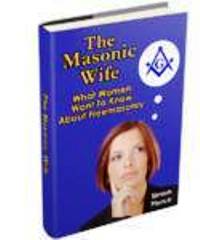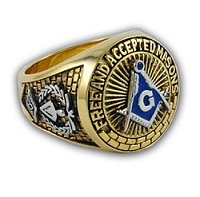Anno Lucis

Anno Lucis is Latin for "Year of Light." You will also see it abbreviated as "A.L." It is used as a calendar system within the Freemason fraternity.
Year of Light refers to the biblical account of the creation of the universe wherein God spoke and said: "Let there be light,...and there was light." (Genesis 1:3)
You will often see the abbreviation "A.L." on Masonic certificates, plaques and building cornerstones.
This calendar system is not exclusive to Freemasonry.
It was designed as a simplification of the Anno Mundi calendar by an Irish cleric, James Ussher (1581-1656) nearly a century before the formation of the United Grand Lodge of England in 1717. Ussher established the year 4004 B.C.
(approximately 6013 years ago) as the date of the biblical creation of the
Earth.
Why does Anno Lucis add 4000 years to the current year?
First, a short refresher on the meanings of B.C.,/B.C.E., C.E./A.D. and A.M.
B.C. /B.C.E.: Before the Christian Era:
Some people remember "B.C." as "Before Christ", which is somewhat appropriate, if not totally politically correct. B.C.E. is also known as "Before Common Era."
B.C.E. denotes the years before
the Christian Era/Common Era. The beginning of the Christian Era is the date when
Christ was assumed to have been born. (I say "assumed", here because not
all religions embrace his birth in their religious belief system and because
biblical scholars are not completely sure of the exact date of his birth.)
C.E./A.D.: Anno Domini:
"In the Year of our Lord" Some people remember "A.D." as "After Death", however A.D. is Latin for Anno Domini, which means "In the Year of our Lord" (referring to Jesus Christ).
In Latin, the base word, "domus" means house, so, technically Anno Domini means In the Year of our House in the Lord". Due to the obvious Christian overtones associated with the term "A.D., many scholars prefer to use more non-secular abbreviations like C.E. to denote the "Common Era."
A.M.: Anno Mundi: "In the Year of the World" Based on rabbinic calculations, A.M. (Anno Mundi) is the date of the year of God's creation of the world. Since about the 9th century, various dates have been advanced by Jewish scholars.
The current date which is generally accepted within Judaism is October 7, 3761 B.C.
This date is based on calculations performed by Rabbis using the book of Genesis to calculate genealogy mentioned in Genesis and then to add the time that has elapsed since Genesis was written.
Most notably, the calculations are based upon the Seder Olam Rabbah of Rabbi
Yose Ben Halafta in the second century C.E. (Common Era.)
Determining Anno Lucis
Anno Lucis: Determining the Year of Light
Hebrew Calendar: The Hebrew
calendar is based upon the Torah (the 5 Books of Moses) which contains several
calendar-related commandments, one of which is God's commandment during the
Exodus from Egypt to affix the month of Aviv as the first month of the year.
Therefore, it is interesting to note that our current Gregorian calendar in use, today is different from the Hebrew calendar as related in the Torah (known to Christians as part of the Old Testament.)
Those of the Jewish faith conform to the Gregorian calendar and its use as a "civil calendar" (used to denote days of work and other dates.) They use the Hebrew calendar to celebrate religious festivals as set out in the Torah.
According to the original Hebrew calendar, the year 2009 (after Rosh Hashanah in September) would be the year 5770. (2009 + 3761.)
Julian Calendar - 46 B.C.: We currently use a form of the Julian Calendar. It was a solar calendar introduced by Julius Caesar in Rome in 46 B.C. It was slightly modified by Augustus.
It established our current 12-month year of 365 days with each 4th year having 366 days and delineates the months having 31 or 30 days except for February.
Each 4th year is called a Leap Year because we add one more day in February.
Gregorian calendar - 1582 A.D. to Present: The Gregorian calendar is the solar calendar in general use, today. The need for the introduction of the Gregorian Calendar came about because a year is not exactly 365 days long. It is actually 365 and a quarter days long.
The Gregorian calendar was introduced by Pope Gregory XIII in 1582 to correct an error in the Julian calendar by suppressing (omitting) 10 days, which incorrectly made October 5th be designated as October 15th, and it provided that only centenary years (years divisible by 100) which were also divisible by 400 should be leap years.
1752: The Gregorian calendar was adopted by Great
Britain and the American colonies in 1752.
Anno Lucis by
Dr. Albert Mackey
Anno Lucis
Albert Mackey, Freemason historian, in his
Revised Encyclopedia of Freemasonry published in 1920 describes Anno Lucis as
follows:
Anno Lucis: "The date used in ancient Craft Masonry; found by adding 4000 to the Vulgar Era; thus, 1911 + 4000 = 5911.
Anno Mundi: In the Year of the World. The date used in the Ancient and Accepted Rite; found by adding 3760 to the Vulgar Era until September. After September, add one year more; this is because the year used is the Hebrew one, which begins in September. Thus, July, 1911 + 3760 = 5771, and October, 1911 + 3760 + 1 = 5672."
End of Albert Mackey
The "Vulgar" era which Dr. Mackey
describes is what we now call our current year. Vulgar is defined as
lacking quality, taste or refinement.
What Year was Latin omitted from
English Craft Certificates?
From 1755 until 1819, original Grand Lodge Certificates were written in
English, only.
In 1819, the United Grand Lodge of England (U.G.L.E.) began producing certificates in both Latin and English.
From 1766, the Antient's Grand Lodge issued certificates in English and Latin.
January, 1965: The United Grand Lodge of England (U.G.L.E.)
omitted Latin from Grand Lodge certificates.
For more information, about the history of English Craft certificates, see T.O. Haunch's paper in Ars Quatuor Coronatorum, Volume 82, 1969 (class mark: A31 QUA) or browse the subject of "certificates" in their Library and Museum Catalogue.
Anno Lucis - Summary
Anno Lucis -
In Summary
As you can see from the foregoing, exact calendar dates are very difficult to discern by scholars because of a lack of written records.
Much like the books of the Bible,
the many changes calendars have undergone have usually been at the behest of
Emperors, Popes and Kings.
- Hebrew Calendar: Based upon the Torah and other rabbinical
works, the Hebrew Calendar establishes the date of the earth's creation by
adding 3761 years (after Rosh Hashanah in the Fall) to the current year.
- Circa Mid 1500s, James Usscher
established the date of the earth's creation as 4004 B.C., thus adding 4004
years to the current year.
- The Freemason calendar
system adds 4000 years to the current year.
What happened to the other 39 years between the Hebrew calendar and the
Freemasons calendar system?
The exact answer is lost to us, today, however
consider this: In suppressing (omitting) 10 days each year from 1 A.D.
thru the mid 1500s, when the Julian calendar was updated to the Gregorian
calendar, this could very nearly account for the 39 year difference between the
Freemason calendar system and the Hebrew calendar. (4000 - 3761)
The study of calendars can be very confusing and very frustrating. Some people with anti-Masonic sentiment (and no knowledge of Latin) fear that Anno Lucis means "in the Year of Lucifer", (a reference to Satan), however nothing could be farther from the truth.
Freemasonry is a very old fraternity. It has many archaic words, like Anno Lucis, within its rituals.
The term, Anno Lucis, is used by Freemasons to denote the Year of Light, which is the year in which God created the world, approximately 4,000 years before the beginning of the Common Era.
Therefore, (2009 + 4000) would be the year 6009 A.L. (Anno Lucis)
5 Fast Methods To Find the Information You Want to Learn About
- Search Box - Use the Search Box at the top of your page.
- Site Map - Use my Site Map page to find the topics you are most interested in.
- Carousel - Use the carousel of pages at the top of your screen.
- Menu Icon - On MOBILE, click the MENU button at the top of each page.
- Masonic Books - Browse through a selection of Masonic books.






